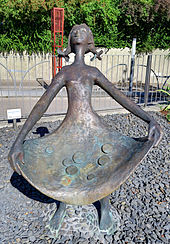Josef Fottner
Josef Fottner (born January 27, 1909 in Munich , † October 7, 1983 in Gröbenzell in Upper Bavaria in the Fürstenfeldbruck district ) was a German painter.
Life
Josef Fottner was born in Munich-Neuhausen near Rotkreuzplatz and grew up as an orphan. In 1922, at the age of 13, he began an apprenticeship in a large painting company in Pfaffenhofen an der Ilm . There he acquired the skills and knowledge that later became the basis for the high technical quality and diversity of his artistic work. After completing his apprenticeship as a church painter, he was involved in the restoration of various castles in and around Munich.
Around 1928 he moved to Chemnitz , where in 1934 he settled down as an independent master painter and worked as a church painter, restorer and commercial artist. During this time he enrolled as a guest student at the Dresden Art Academy and trained as a painter. During these years he already undertook art study trips to Italy, Greece and the mountains.
During the Nazi era, he could not make up his mind to join the Reichskunstkammer because he did not want to share its ideological objectives. During this time he also had no exhibition or publication opportunities. All of his early artistic work was destroyed during the Second World War .
After the turmoil of the war, he settled in Munich from 1945 to 1949 . In 1949 he moved from the big city to the then rather rural community of Gröbenzell . There he ran a painting business.
For years now, the main focus of his painterly work has been landscape paintings, inspired by extensive hikes around Gröbenzell, in the Fürstenfeldbruck district and mountain tours in the Austrian and Swiss high mountains. Later he went on longer painting trips through Italy, southern France and parts of Spain.
With increasing age he concentrated exclusively on his artistic work. In the last decade of his life he turned more to non-representationalism. From the end of the 1960s onwards, he tended to simplify and abstract natural forms more and more. This development can be seen particularly clearly in his woodcuts.
He was on friendly terms with other artists of his time. B. with Thomas Niederreuther , Josef Steiner and Josef Seidl-Seitz.
In 1975 he moved to Ausernzell in the Bavarian Forest and came back to Gröbenzell in 1982, where he died the following year.
Josef Fottner was a member of several artist organizations. In addition to others in the Danube Forest Group founded in 1946 and in the Fürstenfeldbruck artists' association. Occasionally he took part in the great German art exhibition in the Munich House of Art . His works are included in the Niederreuther Foundation.
Selected exhibitions
| year | event | place |
|---|---|---|
| 1949, 1953 | Art exhibition | Dresden |
| 1953 | International art exhibition | Bucharest |
| 1957 | Alpine Club | Frankfurt / Main |
| 1965-1969 | Professional Association of Visual Artists | Munich |
| 1969-1972 | Large art exhibition in the House of Art | Munich |
| 1977-1979 | Great art exhibition | Moated castle |
| 1988 | Painter in Bruck (posthumously) | Fürstenfeldbruck |
| 1993 | large individual memorial exhibition | Fürstenfeldbruck City Museum in the Fürstenfeld Monastery |
| 1996 | Solo exhibition | Thoma Gallery Pähl (now Starnberg) |
Anecdotal
In 1965, the Gröbenzell artist Ferdinand Auerhammer created the approximately 1.50 meter high bronze figure Sterntaler on behalf of Sparkasse Fürstenfeldbruck on the occasion of the new building of the Sparkasse branch in Gröbenzell . In the manner customary at the time, the figure shows the girl from Grimm's fairy tale Die Sterntaler , who holds up her skirt to catch the silver coins falling from the night sky. This “coin collector” stood in front of the Sparkasse Gröbenzell for many years. The coins are depicted three-dimensionally and have different inscriptions. One shows the production year 1965, another the inscription: "The architect + artists". In addition to the sculptors Visino and Wolf Hirtreiter , a coin was also dedicated to Josef Fottner with the imprint “Kunstmaler Fottner”. The sculpture originally served as a fountain figure, on whose raised skirt the jets of water met. With the renovation of the S-Bahn station, the fountain system disappeared, the figure remained.
Exemplary works
| personal data | |
|---|---|
| SURNAME | Fottner, Josef |
| BRIEF DESCRIPTION | German painter |
| DATE OF BIRTH | January 27, 1909 |
| PLACE OF BIRTH | Munich |
| DATE OF DEATH | October 7, 1983 |
| Place of death | Groebenzell , Fürstenfeldbruck district |







